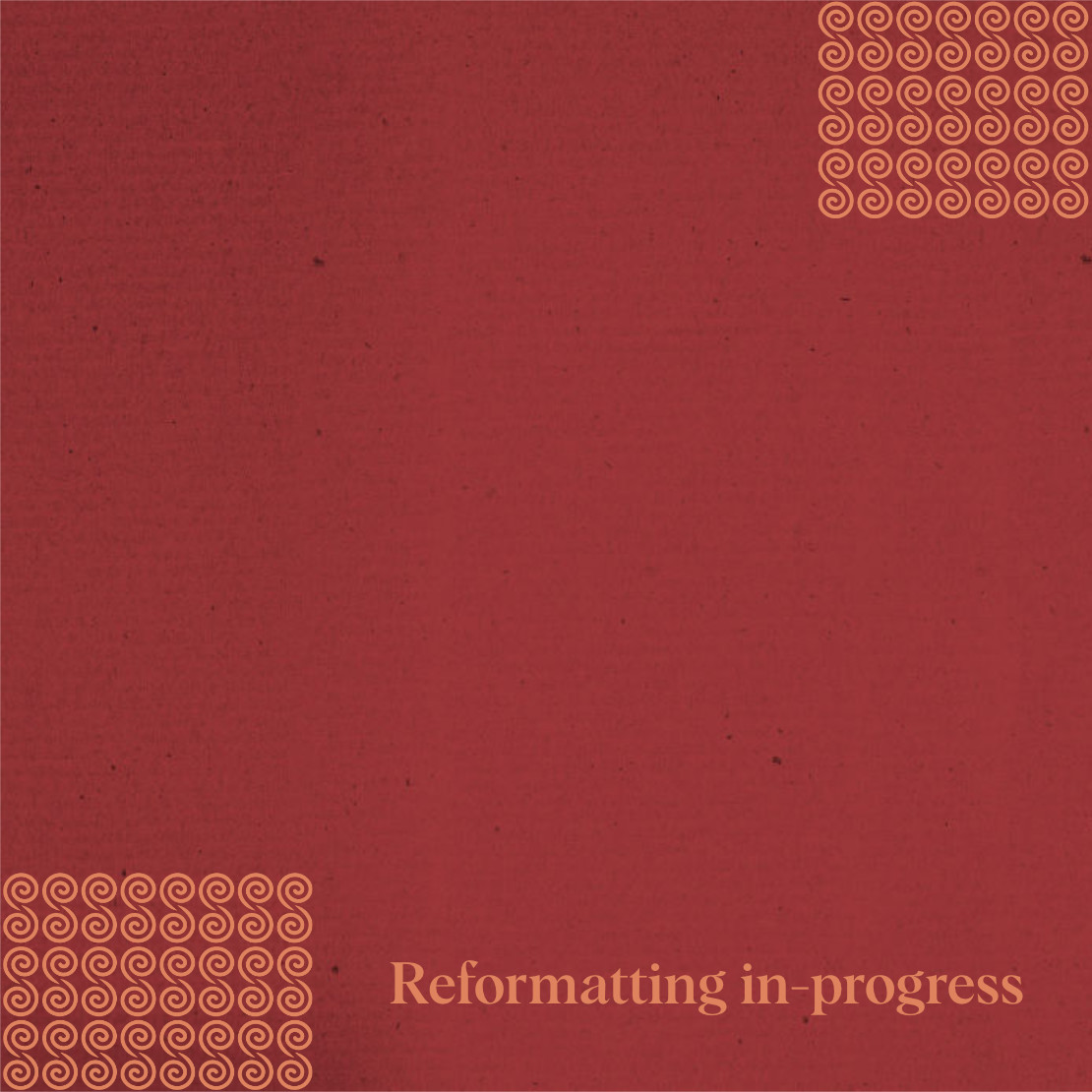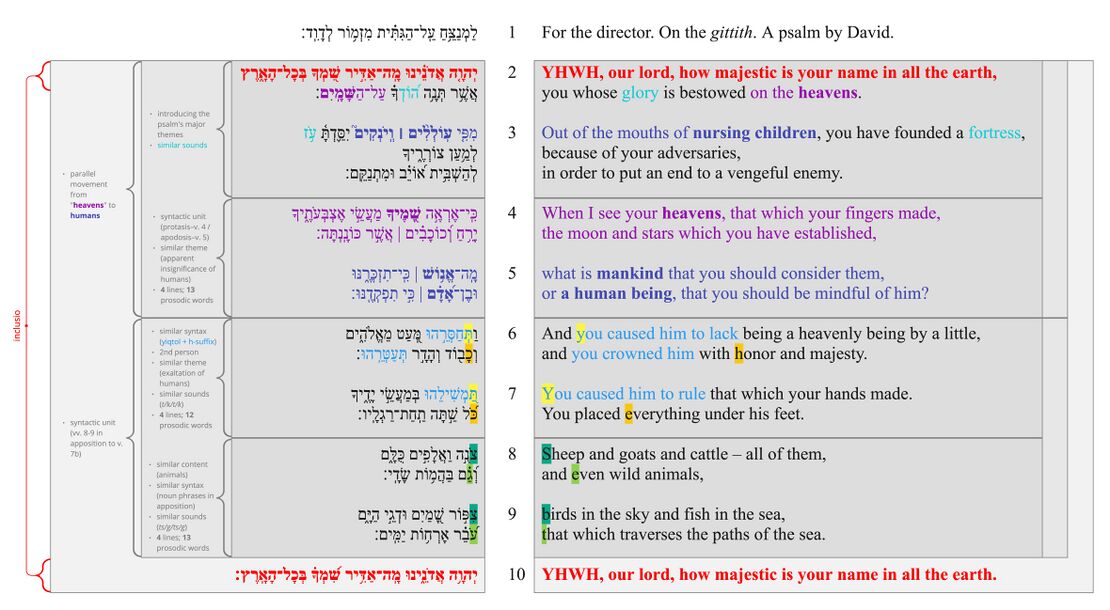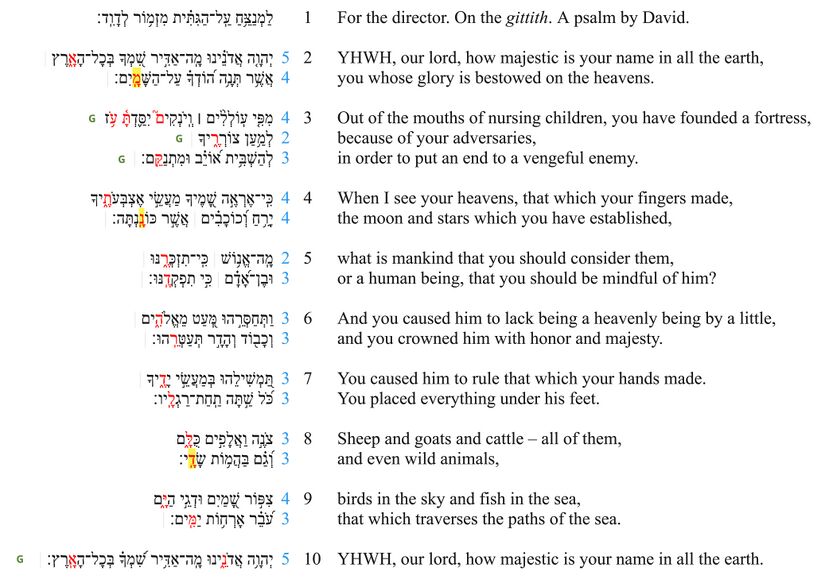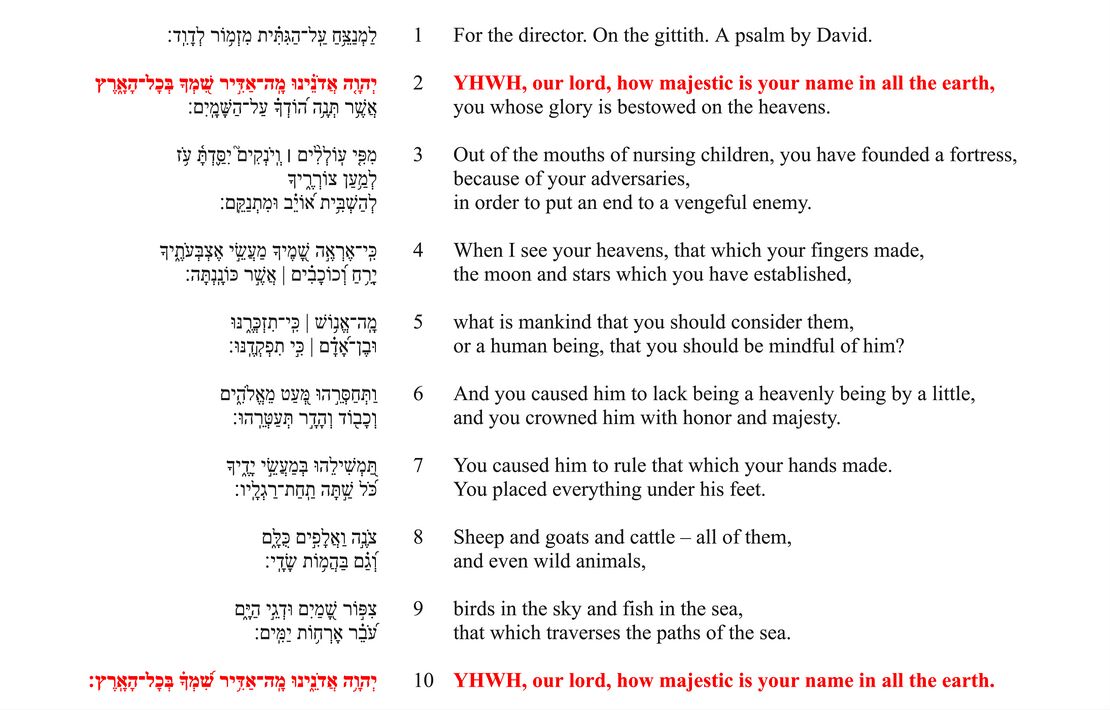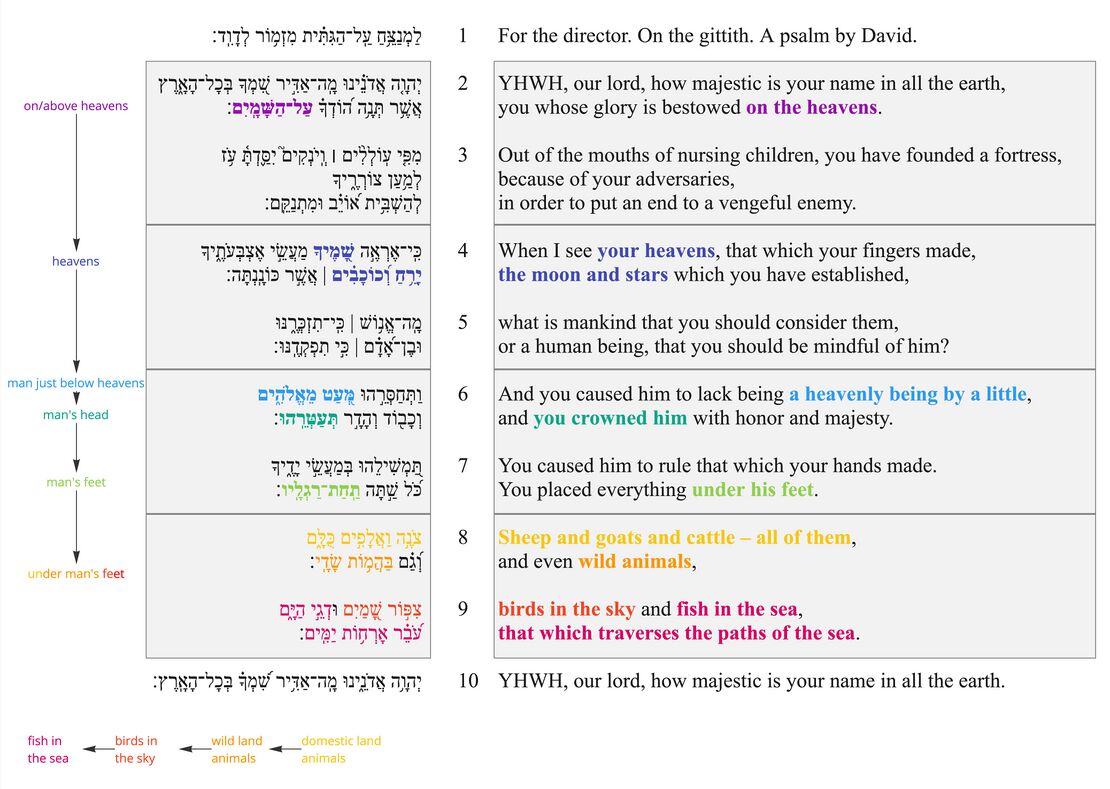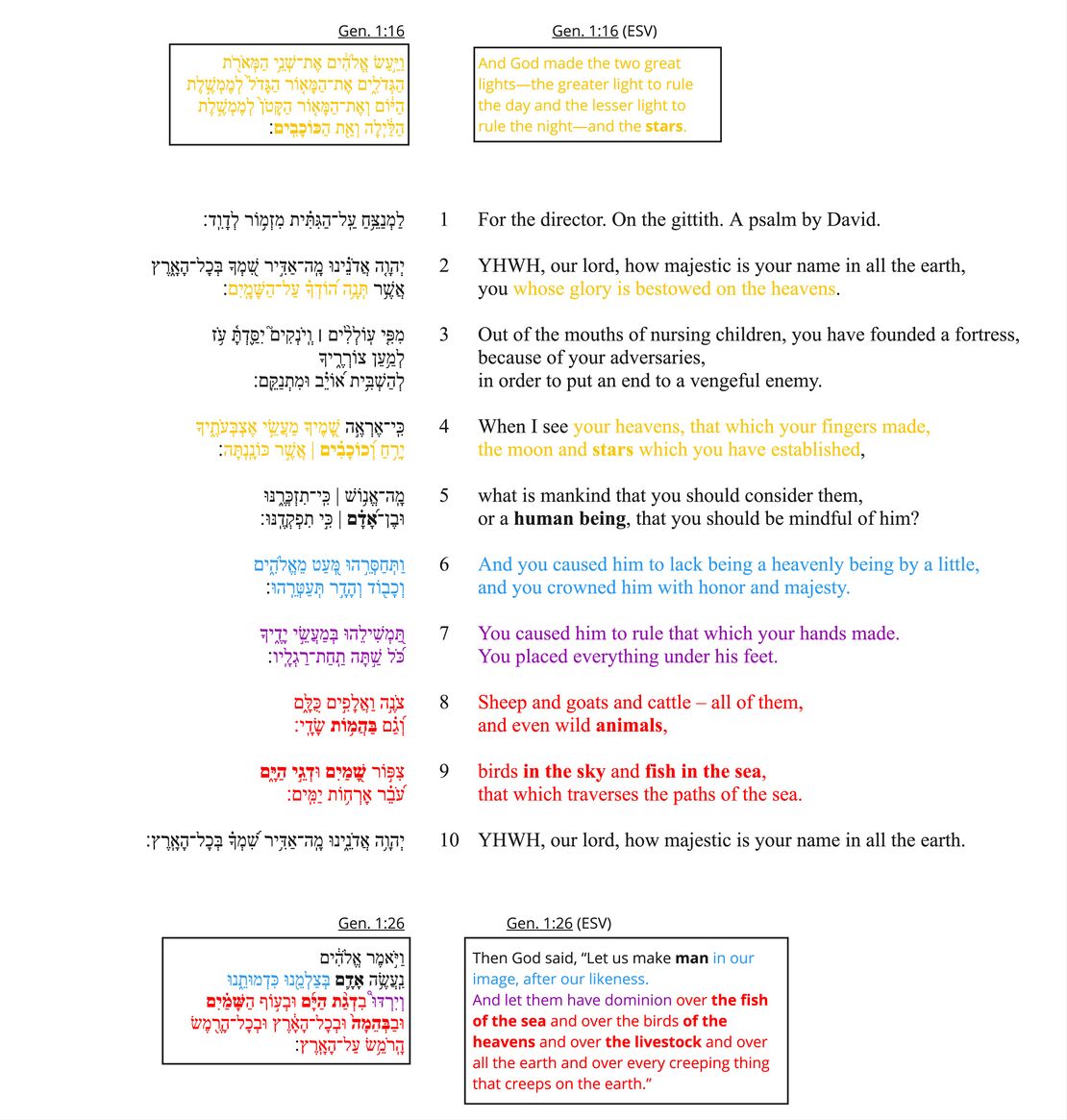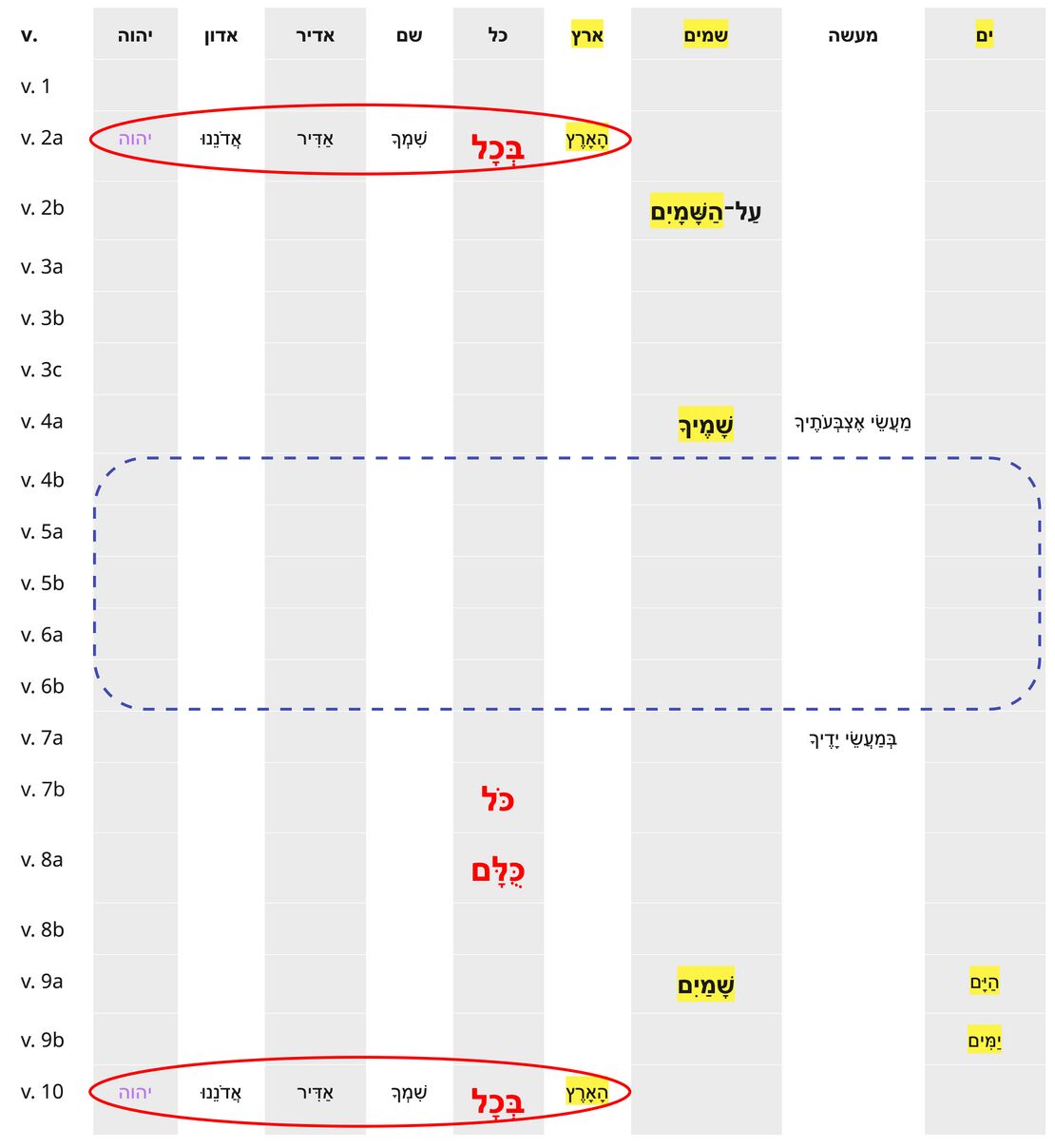Psalm 8 Poetry
About the Poetics Layer
Exploring the Psalms as poetry is crucial for understanding and experiencing the psalms and thus for faithfully translating them into another language. This layer is comprised of two main parts: Poetic Structure and Poetic Features.
Poetic Structure
In poetic structure, we analyse the structure of the psalm beginning at the most basic level of the structure: the line (also known as the “colon” or “hemistich”). Then, based on the perception of patterned similarities (and on the assumption that the whole psalm is structured hierarchically), we argue for the grouping of lines into verses, verses into sub-sections, sub-sections into larger sections, etc. Because patterned similarities might be of various kinds (syntactic, semantic, pragmatic, sonic) the analysis of poetic structure draws on all of the previous layers (especially the Discourse layer).
Poetic Macro-structure
If an emendation or revocalization is preferred, that emendation or revocalization will be marked in the Hebrew text of all the visuals.
| Emendations/Revocalizations legend | |
|---|---|
| *Emended text* | Emended text, text in which the consonants differ from the consonants of the Masoretic text, is indicated by blue asterisks on either side of the emendation. |
| *Revocalized text* | Revocalized text, text in which only the vowels differ from the vowels of the Masoretic text, is indicated by purple asterisks on either side of the revocalization. |
| v. 1 For the director. On the gittith. A psalm by David. |
Superscription |
|||
| v. 2 YHWH, our lord, how majestic is your name in all the earth, you whose glory is bestowed on the heavens. |
Introduction |
“How majestic is your name…” Glory on the heavens; strength through children |
amazement |
|
| v. 3 Out of the mouths of nursing children, you have founded a fortress, because of your adversaries, in order to put an end to a vengeful enemy. | ||||
| v. 4 When I see your heavens, that which your fingers made, the moon and stars which you have established, |
Question |
“When I look at your heavens… What is mankind?” |
||
| v. 5 what is mankind that you should consider them, or a human being, that you should be mindful of him? | ||||
| v. 6 And you caused him to lack being a heavenly being by a little, and you crowned him with honor and majesty. |
Answer |
“Crowned with honor and majesty” |
||
| v. 7 You caused him to rule that which your hands made. You placed everything under his feet. | ||||
| v. 8 Sheep and goats and cattle – all of them, and even wild animals, |
“Everything under his feet” |
|||
| v. 9 birds in the sky and fish in the sea, that which traverses the paths of the sea. | ||||
| v. 10 YHWH, our lord, how majestic is your name in all the earth. |
Closing |
“How majestic is your name…” |
||
Notes
- vv. 2a, 10. The psalm is bound by an inclusio (cf. the inclusio in Ps 103).
- vv. 2b-3. Verse 2b is connected both to the previous line and to the following lines. As Waltke writes, "Verse 2b is a janus. It is linked to the superscript 2a by an exceptional relative 'who,' by the Masoretic accents that retain the earliest known interpretation of the psalm, and by this parallelism: (A) I AM (B) how majestic is your name (C) in all the earth // (A') You who (B') place your splendor (C') upon the heavens."[1] There are also sound correspondences that join v. 2b and v. 2a (shamayim // shimka; tenah // mah; adir // hod). At the same time, v. 2b is connected to the body of the psalm, introducing the theme of glory on the heavens (cf. v. 4f) and the point of departure for the vertical descent that runs throughout the rest of the psalm ("on/above the heavens", see poetic feature #2).
- vv. 4-5. Verses 4-5 are bound together as a single syntactic unit; v. 4 is the protasis ("when..."), and v. 5 is the apodosis ("then..."). These two verses share a similar theme: the apparent insignificance of humanity (v. 5) compared with the heavens (v. 4). This section is parallel to the previous section; both move from the heavens above (v. 2b // v. 4) to weak humanity below (v. 3 // v. 5).
- vv. 6-7. Verses 6-7 are bound together by similar syntax (the use of 2ms yiqtol verbs with he suffixes), a similar theme (the exaltation of humans), and the alternating sequence of lines that begin with tav and kaf. Some see a chiasm in the verb forms.
- vv. 8-9. Verses 8-9 are bound together by similar syntax (appositional noun phrases), similar content (animals), and an alternating sequence of lines that begin with ts and g.[2]
The first half of Psalm 8 ends with a rhetorical question (v. 5) which is then answered in the second half of the psalm (vv. 6-9). Cf. Ps 11.
Line Divisions
Line division divides the poem into lines and line groupings. We determine line divisions based on a combination of external evidence (Masoretic accents, pausal forms, manuscripts) and internal evidence (syntax, prosodic word counting and patterned relation to other lines). Moreover, we indicate line-groupings by using additional spacing.
When line divisions are uncertain, we consult some of the many psalms manuscripts which lay out the text in lines. Then, if a division attested in one of these manuscripts/versions influences our decision to divide the text at a certain point, we place a green symbol (G, DSS, or MT) to the left of the line in question.
| Poetic line division legend | |
|---|---|
| Pausal form | Pausal forms are highlighted in yellow. |
| Accent which typically corresponds to line division | Accents which typically correspond to line divisions are indicated by red text. |
| | | Clause boundaries are indicated by a light gray vertical line in between clauses. |
| G | Line divisions that follow Greek manuscripts are indicated by a bold green G. |
| DSS | Line divisions that follow the Dead Sea Scrolls are indicated by a bold green DSS. |
| M | Line divisions that follow Masoretic manuscripts are indicated by a bold green M. |
| Number of prosodic words | The number of prosodic words are indicated in blue text. |
| Prosodic words greater than 5 | The number of prosodic words if greater than 5 is indicated by bold blue text. |
If an emendation or revocalization is preferred, that emendation or revocalization will be marked in the Hebrew text of all the visuals.
| Emendations/Revocalizations legend | |
|---|---|
| *Emended text* | Emended text, text in which the consonants differ from the consonants of the Masoretic text, is indicated by blue asterisks on either side of the emendation. |
| *Revocalized text* | Revocalized text, text in which only the vowels differ from the vowels of the Masoretic text, is indicated by purple asterisks on either side of the revocalization. |
Notes
- vv. 2-3. The line division of vv. 2-3 is difficult. In the visual above, v. 2b is taken as a verse together with v. 2a, and the phrase מִפִּ֤י עֽוֹלְלִ֨ים ׀ וְֽיֹנְקִים֮ is grouped with what follows rather than what precedes. This division follows the traditional interpretation of the Masoretic accents which is supported also by the ancient versions (LXX [cf. Matt. 21:16], Jerome, Peshitta, Targum). See [1].
- v. 3. No division is made at the sinnor in v. 3, since this would leave יִסַּ֪דְתָּ֫ עֹ֥ז on its own line, and lines do not usually have one prosodic word.[3]
Poetic Features
In poetic features, we identify and describe the “Top 3 Poetic Features” for each Psalm. Poetic features might include intricate patterns (e.g., chiasms), long range correspondences across the psalm, evocative uses of imagery, sound-plays, allusions to other parts of the Bible, and various other features or combinations of features. For each poetic feature, we describe both the formal aspects of the feature and the poetic effect of the feature. We assume that there is no one-to-one correspondence between a feature’s formal aspects and its effect, and that similar forms might have very different effects depending on their contexts. The effect of a poetic feature is best determined (subjectively) by a thoughtful examination of the feature against the background of the psalm’s overall message and purpose.
How Majestic
If an emendation or revocalization is preferred, that emendation or revocalization will be marked in the Hebrew text of all the visuals.
| Emendations/Revocalizations legend | |
|---|---|
| *Emended text* | Emended text, text in which the consonants differ from the consonants of the Masoretic text, is indicated by blue asterisks on either side of the emendation. |
| *Revocalized text* | Revocalized text, text in which only the vowels differ from the vowels of the Masoretic text, is indicated by purple asterisks on either side of the revocalization. |
Feature
The last line of the psalm (v. 10) repeats the first line (v. 2a) verbatim: יְהוָה אֲדֹנֵינוּ מָה־אַדִּיר שִׁמְךָ בְּכָל־הָאָרֶץ
Effect
"A perfect circle is closed: the majesty of God, affirmed at the beginning, restated verbatim at the end, but with the sense accrued through the intervening eight lines of what concretely it means for His name to be majestic throughout the earth."[4] The "sense accrued" throughout the psalm is surprising. The opening declaration of Yahweh's majesty (v.2ab) is expounded, perhaps unexpectedly, with images of helpless children (v.3) and frail humans (v.5). When the same words are repeated in v.10, the meaning has developed in a surprising way: Yahweh's royal majesty is manifested in weakness.
From Top to Bottom
If an emendation or revocalization is preferred, that emendation or revocalization will be marked in the Hebrew text of all the visuals.
| Emendations/Revocalizations legend | |
|---|---|
| *Emended text* | Emended text, text in which the consonants differ from the consonants of the Masoretic text, is indicated by blue asterisks on either side of the emendation. |
| *Revocalized text* | Revocalized text, text in which only the vowels differ from the vowels of the Masoretic text, is indicated by purple asterisks on either side of the revocalization. |
Feature
"Throughout the first six verses of the poem, the poet has subtly woven in a motif of vertical descent: v.2c above heavens → v.4a heavens... moon and stars → v.6a but a little lower than heavenly beings → v.6b crowned them (a reference to the head) → v.7a hands → v.7b feet. Having descended to earth, the psalmist now changes directions and describes a horizontal vector that moves outward from human society: sheep and oxen → beasts of the field → birds → fish → whatever passes the paths of the seas."[5]
Effect
YHWH's majesty is evident in the greatest heights of the heavens (v. 2b) as well as in the lowest depths of the ocean (v. 9b). The whole world displays the majesty of its creator and king (vv. 2a, 10).
At the center of creation (and the center of the psalm) are humans who stand between heaven and earth as the "image of God" (Gen 1:26f) and the mediators of God's rule.
In the Beginning
If an emendation or revocalization is preferred, that emendation or revocalization will be marked in the Hebrew text of all the visuals.
| Emendations/Revocalizations legend | |
|---|---|
| *Emended text* | Emended text, text in which the consonants differ from the consonants of the Masoretic text, is indicated by blue asterisks on either side of the emendation. |
| *Revocalized text* | Revocalized text, text in which only the vowels differ from the vowels of the Masoretic text, is indicated by purple asterisks on either side of the revocalization. |
Feature
Ps 8:8-9 lists three basic categories of animals: (1) land animals, domestic and wild (v. 8), (2) birds (v. 9aα), (3) fish (v. 9aβb). This taxonomy closely resembles the list of animals in Gen 1:26-28, though the two passages use slightly different terminology (עוף vs צפור for "birds" and בהמות שדי vs חיה for "wild animals"): (1) land animals, domestic and wild (2) birds, (3) fish.
In addition to the listing of animals, the description of man's dominion in Ps 8:6-7 also recalls Genesis 1:26-28 and the creation of man as God's image "to rule" the animals. Likewise, the description of "glory on the heavens" (v. 2b) may recall the dominion which YHWH gave to the heavenly bodies (Gen 1:16-18).
Effect
The parallels between Gen 1:26-28 and Ps 8 lead Waltke to conclude that "Psalm 8 is Genesis 1:26-28 set to music."[6] Similarly, Gentry says that Ps 8:6-9 is "a word-by-word commentary and meditation on Genesis 1:26-28."[7] The different terms used for wild animals and birds in Ps 8 – words which are normally used for domestic creatures – may have been chosen in order to affirm the fact that these creatures are subject to humans.[8]
Repeated Roots
The repeated roots table is intended to identify the roots which are repeated in the psalm.
| Repeated Roots legend | |
|---|---|
| Divine name | The divine name is indicated by bold purple text. |
| Roots bounding a section | Roots bounding a section, appearing in the first and last verse of a section, are indicated by bold red text. |
| Roots occurring primarily in the first section are indicated in a yellow box. | |
| Roots occurring primarily in the third section are indicated in a blue box. | |
| Roots connected across sections are indicated by a vertical gray line connecting the roots. | |
| Section boundaries are indicated by a horizontal black line across the chart. | |
Bibliography
- Alter, Robert. 1985. The Art of Biblical Poetry. New York: Basic Books.
- Anderson, A. A. 1972. The Book of Psalms. Vol. 1. NCBC. Greenwood, SC: Attic.
- Baethgen, Friedrich. 1904. Die Psalmen. Göttingen: Vandenhoeck und Ruprecht.
- Barthélemy, Dominique. 2005. Critique Textuelle de l’Ancien Testament. Tome 4: Psaumes. Fribourg, Switzerland: Academic Press.
- Boyd, Stephen W. 2017. “The Binyanim (Verbal Stems).” In Where Shall Wisdom Be Found? A Grammatical Tribute to Professor Stephen A. Kaufman, edited by Hélène M. Dallaire, Benjamin J. Noonan, and Jennifer E. Noonan. Eisenbrauns.
- Bratcher, Robert G., and William D. Reyburn. 1991. A Translator's Handbook on the Book of Psalms. New York: UBS Handbook Series.
- Briggs, Charles and Emilie Briggs. 1906. A Critical and Exegetical Commentary on the Book of Psalms. International Critical Commentary. New York: C. Scribner’s Sons.
- Brown, William. 2002. Seeing the Psalms: A Theology of Metaphor. Louisville: Westminster John Knox Press.
- Brueggemann, Walter, and William H. Bellinger Jr. 2014. Psalms. New Cambridge Bible Commentary. Cambridge: Cambridge University Press.
- Craigie, Peter C. 2004. Word Biblical Commentary: Psalms 1–50. 2nd ed. Vol. 19. Nashville, TN: Nelson Reference & Electronic.
- Dahood, Mitchell J. 1966. The Anchor Bible: Psalms I, 1-50. Garden City, NY: Doubleday.
- Delitzsch, Franz. 1871. Biblical Commentary on the Psalms. Vol. 1. Edinburgh: T&T Clark.
- Delitzsch, Franz. 1883. A Commentary on the Psalms. New York: Funk and Wagnalls.
- Eaton, John. 2003. The Psalms: A Historical and Spiritual Commentary with an Introduction and New Translation. London; New York: T&T Clark.
- Fokkelman, J.P. 2003. Major Poems of the Hebrew Bible: At the Interface of Prosody and Structural Analysis (Vol 3: The Remaining 65 Psalms). Vol. 3. Studia Semitica Neerlandica. Van Gorcum.
- Gentry, Peter J. 1998. “The System of the Finite Verb in Classical Hebrew.” Hebrew Studies 39:7–39.
- Gentry, Peter J., and Stephen J. Wellum. 2012. Kingdom Through Covenant: A Biblical-Theological Understanding of the Covenants. Wheaton: Crossway.
- Gesenius, W. Donner, H. Rüterswörden, U. Renz, J. Meyer, R. (eds.). 2013. Hebräisches und aramäisches Handwörterbuch über das Alte Testament. Berlin: Springer.
- Hengstenberg, Ernst Wilhelm. 1863. Commentary on the Psalms. Vol. 1. Edinburgh: T. & T. Clark.
- Holmstedt, Robert D. 2016. The Relative Clause in Biblical Hebrew. Indiana: Eisenbrauns.
- Hossfeld, Frank-Lothar, and Erich Zenger. 1993. Die Psalmen I: Psalm 1–50. Neue Echter Bibel. Würzburg: Echter.
- Hupfeld, Hermann. 1855. Die Psalmen. Vol. 1. Gotha: Friedrich Andreas Perthes.
- Ibn Ezra. Ibn Ezra on Psalms.
- Jacobson, R. A. 2014. "Psalm 8," in N. DeClaissé-Walford, R. A. Jacobson & B. L. Tanner (eds.) The Book of Psalms. Grand Rapids, MI: Eerdmans.
- Jero, Christopher. 2017. “Tense, Mood, and Aspect in the Biblical Hebrew Verbal System.” In Where Shall Wisdom Be Found? A Grammatical Tribute to Professor Stephen A. Kaufman, edited by Hélène M. Dallaire, Benjamin J. Noonan, and Jennifer E. Noonan. Eisenbrauns.
- Keel, Othmar. 1997. The Symbolism of the Biblical World: Ancient Near Eastern Iconography and the Book of Psalms. Winona Lake: Eisenbrauns.
- Keener, Hubert James. 2013. A Canonical Exegesis of the Eighth Psalm: YHWH’s Maintenance of the Created Order Through Divine Reversal. Vol. 00009. Winona Lake, Indiana: Eisenbrauns.
- Kraus, Hans-Joachim. 1988. Psalms 1–59. Minneapolis: Fortress.
- Kraut, Judah. 2010. “The Birds and the Babes: The Structure and Meaning of Psalm 8.” The Jewish Quarterly Review. Vol. 100, No. 1, 10-24.
- Lunn, Nicholas P. 2006. Word-Order Variation in Biblical Hebrew Poetry: Differentiating Pragmatics and Poetics. Paternoster Biblical Monographs. Milton Keynes: Paternoster.
- Perowne, J. J. Stewart. 1870. The Book of Psalms: A New Translation with Introductions and Notes, Explanatory and Critical. Vol. I. London: Bell and Daldy.
- Robar, Elizabeth. 2013. “Wayyiqol as an Unlikely Preterite.” Journal of Semitic Studies 58 (1): 21–42.
- ________. 2015. The Verb and the Paragraph in Biblical Hebrew: A Cognitive-Linguistic Approach. Vol. 78. Studies in Semitic Languages and Linguistics. Leiden: Brill.
- Rogerson, J. W., and J. W. McKay. 1977. Psalms. Vol. 1. The Cambridge Bible Commentary on the New English Bible. Cambridge: Cambridge University Press.
- Ross, Allen P. 2011. A Commentary on the Psalms 1-41. Vol. 1. Grand Rapids, MI: Kregel.
- Sarna, Nahum M. 1993. On the Book of Psalms: Exploring the Prayers of Ancient Israel. New York: Schocken.
- Smith, Mark S. 1997. "Psalm 8:2b-3: New Proposals for Old Problems." The Catholic Biblical Quarterly. Vol. 59, No. 4, 637-641.
- Sommer, Benjamin. 2020. “Hebrew Humanism. A Commentary on Psalm 8.” 11: 7*-32*. Studies in Bible and Exegesis (עיוני מקרא ופרשנות).
- Stec, David M. 2004. The Targum of Psalms: Translated, with a Critical Introduction, Apparatus, and Notes. Collegeville, MN: Liturgical Press.
- Tate, Marvin E. 2001. "An Exposition of Psalm 8." Perspectives in Religious Studies. 28 (4), 343-359.
- Terrien, Samuel L. 2003. The Psalms: Strophic Structure and Theological Commentary. ECC. Grand Rapids: Eerdmans.
- VanGemeren, Willem. 2008. Psalms: The Expositor's Bible Commentary. Grand Rapids: Zondervan.
- Waltke, Bruce K., J. M. Houston, and Erika Moore. 2010. The Psalms as Christian Worship: A Historical Commentary. Grand Rapids, Mich: William B. Eerdmans Pub. Co.
- Whitekettle, Richard. 2006. “Taming the Shrew, Shrike, and Shrimp: The Form and Function of Zoological Classification in Psalm 8.” JBL 125: pp. 749-65.
- Wilson, Gerald H. 2002. The NIV Application Commentary: Psalms. Vol. 1. Grand Rapids: Zondervan.
- Young, Dwight W. 1960. “Notes on the Root Ntn in Biblical Hebrew.” Vetus Testamentum 10, no. 4: 457–59.
